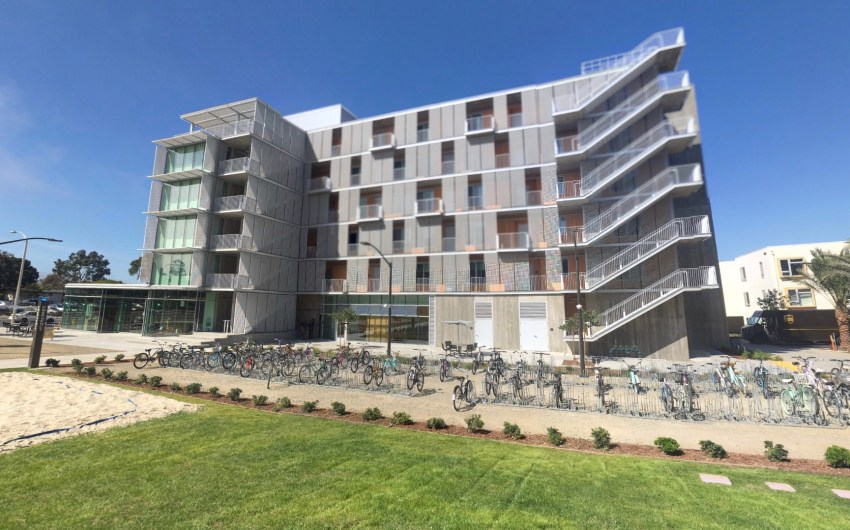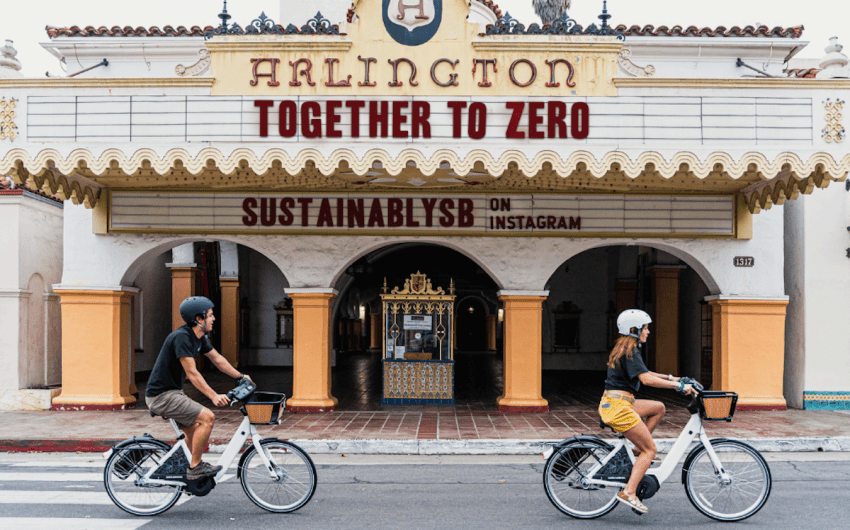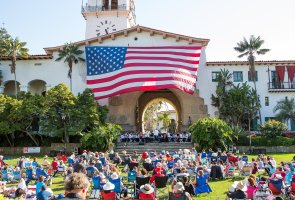UCSB Blends Human and Machine with Media Arts End-of-Year Show
Media Arts and Technology Grad Program Celebrates 25-Year Anniversary, Blurs Lines Between Art and Science

For the last quarter of a century, students with UC Santa Barbara’s Media Arts and Technology graduate program have been working in the untamed wilderness between art and science, where high-level academic research meets the unbounded creativity of modern art. Each year, a new cohort of grad students continue to push the boundaries, blurring the lines between the analytical “left-brained” researcher and the free-wheeling “right-brained” artist.
This week, the program hosted two nights to celebrate its 25th anniversary and to showcase the latest batch of student work with its end-of-year show, “Soft AI+M” (Artificial Intelligence + Media), featuring an experimental mix of media, from electronic music performances to robotics and computer-aided crafts produced by master’s and PhD students and faculty.

Elings Hall was buzzing — both literally and figuratively — for the first night of the show on June 5, as guests interacted with artworks that invited attendees to touch, play, or become part of the performance themselves.
These included “Spatial Orchestra,” which used an augmented-reality headset to allow users to walk through a Technicolor world of musical instruments, playing different tones as they navigate from color to color.
The “game,” as described by one of the student creators You-Jin Kim, was created as a way to encourage bodily expression through spatial awareness and is intended as an innovative way to approach physical therapy for those learning to walk after an injury. The musical instruments in the virtual world act like a reward system, he explained, which can turn something as painful as physical therapy into a fun activity.
In one piece, a wall of monitors displayed conversations between AI chatbots, complete with lines of code giving a glimpse into the computerized chatters’ “emotional states” motivating the responses. In one exchange, a chatbot called “Lily” says — with frustration and “undercurrents of anxiety and resentment,” according to the text on screen — “I’ll tear through every deceit and snag that backstabber by the throat before the sun sets.”
In response, with what the lines of code describe as “a volatile blend of urgency and intense curiosity,” a chatbot called Samuel warns that “this mission is a reckless move that jeopardizes the safety and morale of the entire team.”
In another work, called “High Five (lo-fi)” by Sam Bourgault, the artist created a robotic arm with a silicone hand attached, which guests could program with a user-specific “secret handshake” that the machine could replicate on demand.
“It’s exciting to see how the MAT program has progressed over the years since its inception, to remain at the cutting edge within a drastically evolving field,” said the program’s chair, Marcos Novak. “MAT students and faculty have pushed the envelope of multi-, inter-, and transdisciplinary work in digital media, with world-class research and creative activities that are published, installed, shown, performed, and discussed in top venues around the world.”
The most immersive exhibit in the show was inside the university’s AlloSphere — a three-story metal sphere that hangs suspended in an echo-free chamber, with 3-D surround sound and 27 projectors capable of re-creating an almost infinite array of video and musical representations of data sets. Up to 20 people can stand on a platform inside the chamber, surrounded on all sides by the display.
It was the brainchild of distinguished professor and chief scientist Dr. JoAnn Kuchera-Morin, who described the AlloSphere as a “large, dynamically varying digital microscope that’s connected to a supercomputer.”
During a 30-minute show, both disorienting and dazzling, Kuchera-Morin and professor Curtis Roads showed just how much could be achieved within the sphere. First, Roads ran through a performance of his musical composition, “Always,” using an audio interface to play synthesized music while two brightly colored spheres danced across the sphere.

Kuchera-Morin then showed how artists could reimagine hard data provided by campus researchers, figuring out new ways to explore and visualize scientific information. Using a gaming controller, physicists could stand inside of a hydrogen atom, hearing the electrons spinning across the sphere, while mathematicians could watch a five-dimensional geometric equation unfold all around them.
Since its inception, the AlloSphere has served as a playground for researchers and artists, who are limited only by their imaginations in thinking of new ways to use the technology.
“People ask, ‘What do artists know about science?’” Kuchera-Morin said. “Well, we do know about data representation.”
It is a microcosm of the MAT program itself, and a way for student researchers to use their curiosity to navigate the border between human and machine, and to embrace the capabilities of today’s artificial intelligence without being held back out of fear of being replaced by technology.
“As our world becomes increasingly reliant on emerging technologies,” program chair Novak said, “we’re adopting an important focus of adding much-needed elements of softness and humaneness to what might otherwise become a harsh transition.”
Premier Events
Thu, Jul 04
4:30 PM
Santa Barbara
Flip-flops & Fireworks BBQ at Hilton Santa Barbara
Tue, Jul 09
5:30 PM
Santa Barbara
Teach Me Tango!
Mon, Jul 01
5:00 PM
Santa Barbara
Give a Hoot! A Plant-Powered Benefit for Rooted SB
Wed, Jul 03
1:30 PM
Santa Barbara
Dungeons & Dragons for Tweens
Thu, Jul 04
9:00 AM
Santa Barbara
St Andrews 4th of July Pancake Breakfast
Thu, Jul 04
5:00 PM
Santa Barbara
4th of July Concert Presented by PCVF
Fri, Jul 05
8:30 PM
Santa Barbara
Jaws Sun, Surf and Cinema: FREE Summer Films
Sat, Jul 06
10:00 AM
Santa Barbara
APPLEBOX FREE Family Films at SBIFF’s Riviera Theatre
Sat, Aug 03
10:00 AM
Santa Barbara
APPLEBOX FREE Family Films at SBIFF’s Riviera Theatre
Sat, Aug 17
10:00 AM
Santa Barbara
APPLEBOX FREE Family Films at SBIFF’s Riviera Theatre
Wed, Sep 11
5:30 PM
Santa Barbara
Sewing and Mending Club
Thu, Jul 04 4:30 PM
Santa Barbara
Flip-flops & Fireworks BBQ at Hilton Santa Barbara
Tue, Jul 09 5:30 PM
Santa Barbara
Teach Me Tango!
Mon, Jul 01 5:00 PM
Santa Barbara
Give a Hoot! A Plant-Powered Benefit for Rooted SB
Wed, Jul 03 1:30 PM
Santa Barbara
Dungeons & Dragons for Tweens
Thu, Jul 04 9:00 AM
Santa Barbara
St Andrews 4th of July Pancake Breakfast
Thu, Jul 04 5:00 PM
Santa Barbara
4th of July Concert Presented by PCVF
Fri, Jul 05 8:30 PM
Santa Barbara
Jaws Sun, Surf and Cinema: FREE Summer Films
Sat, Jul 06 10:00 AM
Santa Barbara
APPLEBOX FREE Family Films at SBIFF’s Riviera Theatre
Sat, Aug 03 10:00 AM
Santa Barbara
APPLEBOX FREE Family Films at SBIFF’s Riviera Theatre
Sat, Aug 17 10:00 AM
Santa Barbara
APPLEBOX FREE Family Films at SBIFF’s Riviera Theatre
Wed, Sep 11 5:30 PM
Santa Barbara























You must be logged in to post a comment.